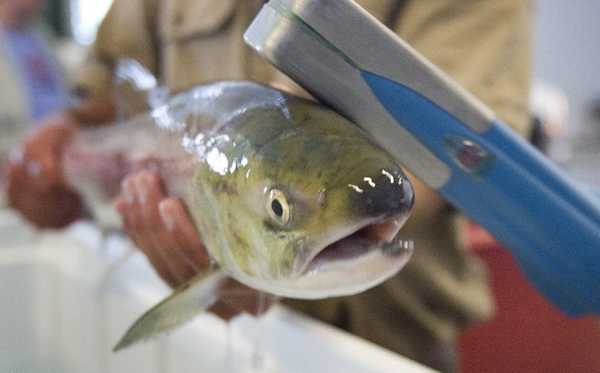forum
library
tutorial
contact

F&G Management Plans Helping
in the Sockeye Recovery
by Cal GroenIdaho Statesman, August 12, 2008
|
the film forum library tutorial contact |

|
F&G Management Plans Helping
by Cal Groen |
 The number of sockeye salmon returning to Central Idaho this year has generated media attention that is a testament to the value of these unique fish.
The number of sockeye salmon returning to Central Idaho this year has generated media attention that is a testament to the value of these unique fish.
Idaho's sockeye salmon migrate farther from the ocean to spawn, about 900 miles, and to a higher elevation, more than 6,500 feet, than any other sockeye population in North America.
Sockeye are icons of Redfish Lake in the Stanley Basin, and their return is in part the result of management and recovery efforts of Idaho Department of Fish and Game and the Shoshone-Bannock tribes, with funding support from federal dam mitigation programs.
In the July 30 edition of the Idaho Statesman, Terry Flores of Portland stated that "sockeye first became endangered because the Idaho Fish and Game poisoned them to establish a trout fishery in Redfish and Stanley Basin lakes in the early 1950s."
Yes, it is true that Fish and Game treated three lakes in the Stanley Basin to increase the trout production: Stanley in 1954, Pettit in 1960 and Yellowbelly in 1961. Of the three, Stanley Lake had the greatest potential to produce sockeye.
Fish and Game never poisoned Redfish and Alturas lakes, the two major sockeye-producing lakes in the basin.
Federal fishery research suggests that neither Yellowbelly nor Pettit lakes are large enough to support independent populations of sockeye. In the sockeye's world, those two lakes simply provided additional spawning and rearing space in years when large numbers of sockeye returned to the basin.
Fish and Game might choose a different management tool today, but the status of sockeye in the lakes when they were treated is moot. They were treated at the time to achieve certain management objectives, and I am certain that the treatment did not endanger Snake River sockeye, as Flores states.
Sockeye returns to Redfish Lake since the treatment have ranged from a high of 4,365 adults in 1955 to a low of 11 adults in 1961. Numbers rebounded to near 1,000 adults spawning in Redfish Lake by 1967.
People following the news may have read about the possible causes for this year's greater-than-average sockeye return. Idaho Fish and Game along with the Shoshone-Bannock tribes have worked together to protect and rebuild populations of Snake River sockeye salmon since these special fish were listed.
This year's return suggests that our management programs are benefiting the sockeye salmon, and that we still have an opportunity to recover these magnificent fish.
learn more on topics covered in the film
see the video
read the script
learn the songs
discussion forum
